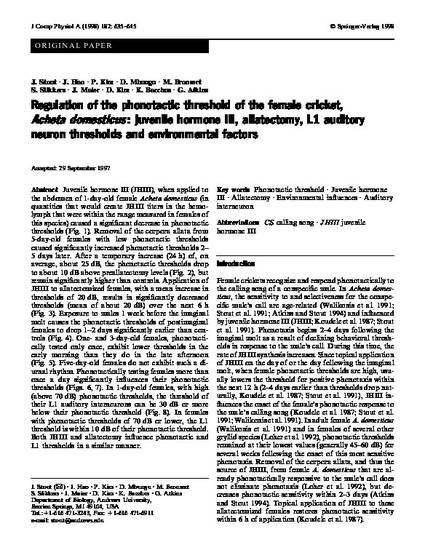
- Allatectomy,
- Auditory interneuron,
- Environmental influences,
- Juvenile hormone III,
- Phonotactic threshold
Juvenile hormone III (JHIII), when applied to the abdomen of 1-day-old female Acheta domesticus (in quantities that would create JHIII titers in the hemolymph that were within the range measured in females of this species) caused a significant decrease in phonotactic thresholds (Fig. 1). Removal of the corpora allata from 5-day-old females with low phonotactic thresholds caused significantly increased phonotactic thresholds 2-5 days later. After a temporary increase (24 h) of, on average, about 25 dB, the phonotactic thresholds drop to about 10 dB above preallatectomy levels (Fig. 2), but remain significantly higher than controls. Application of JHIII to allatectomized females, with a mean increase in thresholds of 20 dB, results in significantly decreased thresholds (mean of about 20 dB) over the next 6 h (Fig. 3). Exposure to males 1 week before the imaginal molt causes the phonotactic thresholds of postimaginal females to drop 1-2 days significantly earlier than controls (Fig. 4). One- and 3-day-old females, phonotactically tested only once, exhibit lower thresholds in the early morning than they do in the late afternoon (Fig. 5). Five-day-old females do not exhibit such a diurnal rhythm. Phonotactically testing females more than once a day significantly influences their phonotactic thresholds (Figs. 6, 7). In 1-day-old females, with high (above 70 dB) phonotactic thresholds, the threshold of their L1 auditory interneurons can be 30 dB or more below their phonotactic threshold (Fig. 8). In females with phonotactic thresholds of 70 dB or lower, the L1 threshold is within 10 dB of their phonotactic threshold. Both JHIII and allatectomy influence phonotactic and L1 thresholds in a similar manner.
Available at: http://works.bepress.com/john_stout/27/
